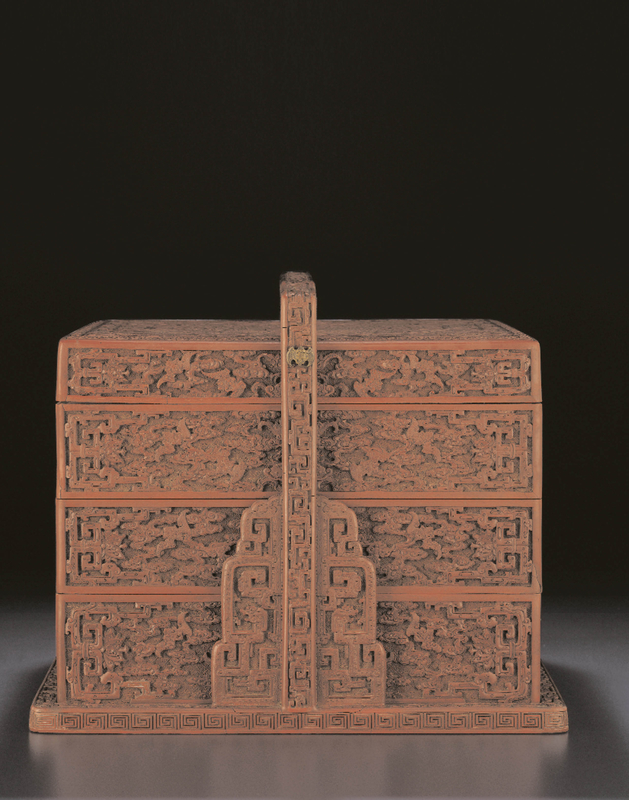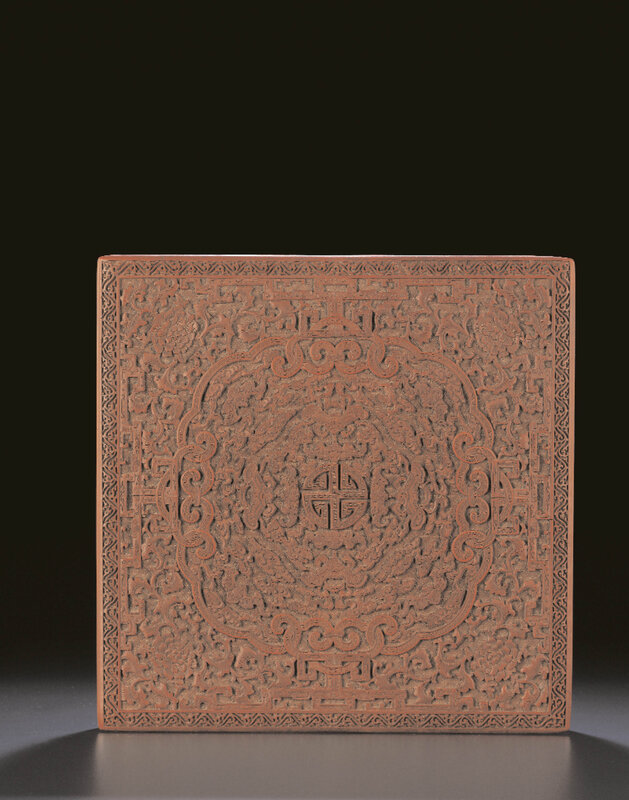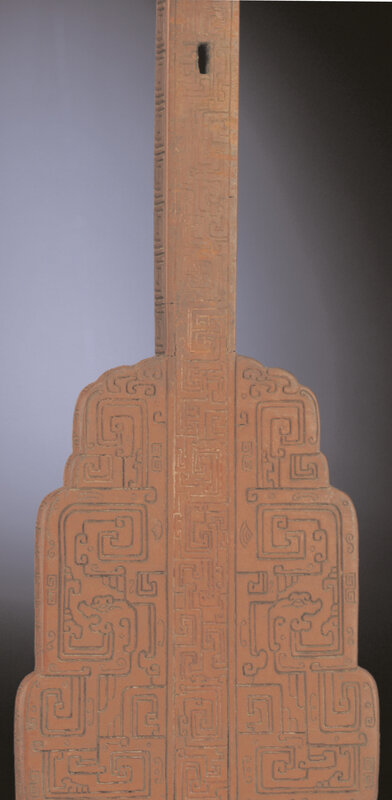A magnificent imperial carved cinnabar lacquer three-tiered travelling box and cover, Qianlong mark and period (1736-1795)






Lot 3575. A magnificent imperial carved cinnabar lacquer three-tiered travelling box and cover, Qianlong incised and gilt six-character mark and of the period (1736-1795); 11 3/4 x 14 x 14 in. (29.9 x 35.6 x 35.6 cm.). Estimate HKD 4,000,000 - HKD 6,000,000. Price Realized HKD 10,740,000. © Christie's Images Ltd 2011.
The three square-section tiers and cover set on a base frame flanked by standing spandrels and joined at the top with a humpbacked handle, superbly carved to the top of the cover with four bats suspending musical stones around the axes of a central stylised wan character and four further bats amidst swirling clouds at the corners of the interlocking ruyi-shaped keyfret border framing the central cartouche, set with dense blossoming peony scroll and angular scrolling ribbons within a stylised foliate scroll border, each of the sixteen sides of the box and cover similarly carved with five bats amidst clouds centred around a musical stone and wan character framed at the sides by lotus flowers issuing from angular ribbons, the outside of the spandrels carved with angular dragon scroll repeated in shallow relief to the interior sides, the base frame and handle with further archaistic angular scroll and key-fret on the sides, the cover held in place by a brass rod with a bat-shaped finial extending through the two side supports, the interiors and base lacquered black, the base bearing the incised and gilt reign mark, Japanese wood box.
Literature: Bijutsu Senshu Dai Hachi Kan, Cho Shitsu (Carved Lacquer), 1974, Fuji Art Publications, Japan, no. 75.
Exhibited: Osaka Municipal Art Museum, Osaka, Japan, Ming and Qing Ceramics and Works of Art, 1980, illustrated in the Catalogue, p. 53, no. 2:36.
Note: This box appears to be unique with no other comparable examples of this form and decoration published. A late Ming carved cinnabar lacquer picnic or travelling box of much more conventional smaller rectangular form in the Palace Museum Collection, Beijing, is published by Wang Shixiang, Zhongguo Gudai Qiqi, Beijing, 1987, no. 56.
The box is likely to have been an Imperial commission for Imperial outdoor travel and leisure activities. A number of paintings in the Imperial collections depict the Yongzheng and Qianlong emperors using picnic boxes of this type on excursions. The Yongzheng emperor is shown seated beside a tiered black lacquer or mother-of-pearl inlaid lacquer picnic box in an anonymous painting in the Palace Museum Collection, Beijing illustrated in Paintings by the Court Artists of the Qing Court, The Complete Collection of Treasures of the palace Museum, Hong Kong, 1996, pp. 124-125, no. 19. A picnic box, possibly cinnabar lacquer, of comparable form and large size to the present example is depicted on a barge accompanying the Qianlong Emperor in the Ninth Scroll of Emperor Qianlong's Tour of Southern China, Qianlong Nan Xun Tu, by Xu Yang included in the Macau Museum of Art Exhibition The Life of Emperor Qianlong, Macau, 2002, no. 110.
A gilt black lacquer portable tea-ceremony chest of similar construction in the Palace Museum Beijing is illustrated in Lacquer Wares of the Qing Dynasty, The Complete Collection of Treasures of the Palace Museum, Hong Kong, 2006, p. 174, no. 129.
For a discussion of tiered handled boxes, tihe and their function, see Wang Shixiang, Connoisseurship of Chinese Furniture, Vol I: Text, Hong Kong, 1990, p. 95 where the author notes that few examples of tihe have survived due to their fragility and the fact that larger examples such as the present box were usually made of softwood. Surviving examples are mostly small boxes in zitan or huanghuali as well as a few inlaid examples.
Christie's. The Imperial Sale, Hong Kong, 1 June 2011

/https%3A%2F%2Fprofilepics.canalblog.com%2Fprofilepics%2F1%2F0%2F100183.jpg)
/https%3A%2F%2Fstorage.canalblog.com%2F03%2F02%2F119589%2F96711876_o.jpg)
/https%3A%2F%2Fstorage.canalblog.com%2F11%2F31%2F119589%2F94773502_o.jpg)
/https%3A%2F%2Fstorage.canalblog.com%2F20%2F83%2F119589%2F94772815_o.jpg)
/https%3A%2F%2Fstorage.canalblog.com%2F26%2F72%2F119589%2F75604929_o.jpg)
/https%3A%2F%2Fstorage.canalblog.com%2F59%2F60%2F119589%2F26458628_o.jpg)


/image%2F1371349%2F20240409%2Fob_73d398_telechargement.jpg)
/http%3A%2F%2Fstorage.canalblog.com%2F86%2F19%2F119589%2F129426368_o.jpg)
/http%3A%2F%2Fstorage.canalblog.com%2F44%2F07%2F119589%2F129425692_o.jpg)
/http%3A%2F%2Fstorage.canalblog.com%2F00%2F88%2F119589%2F129137720_o.jpg)